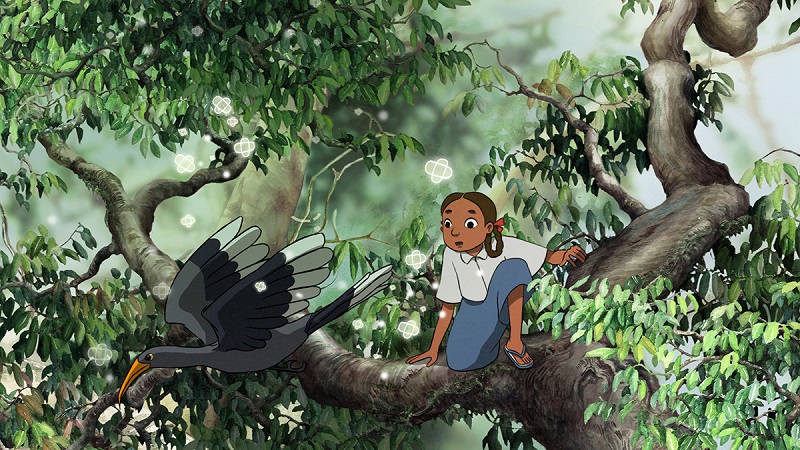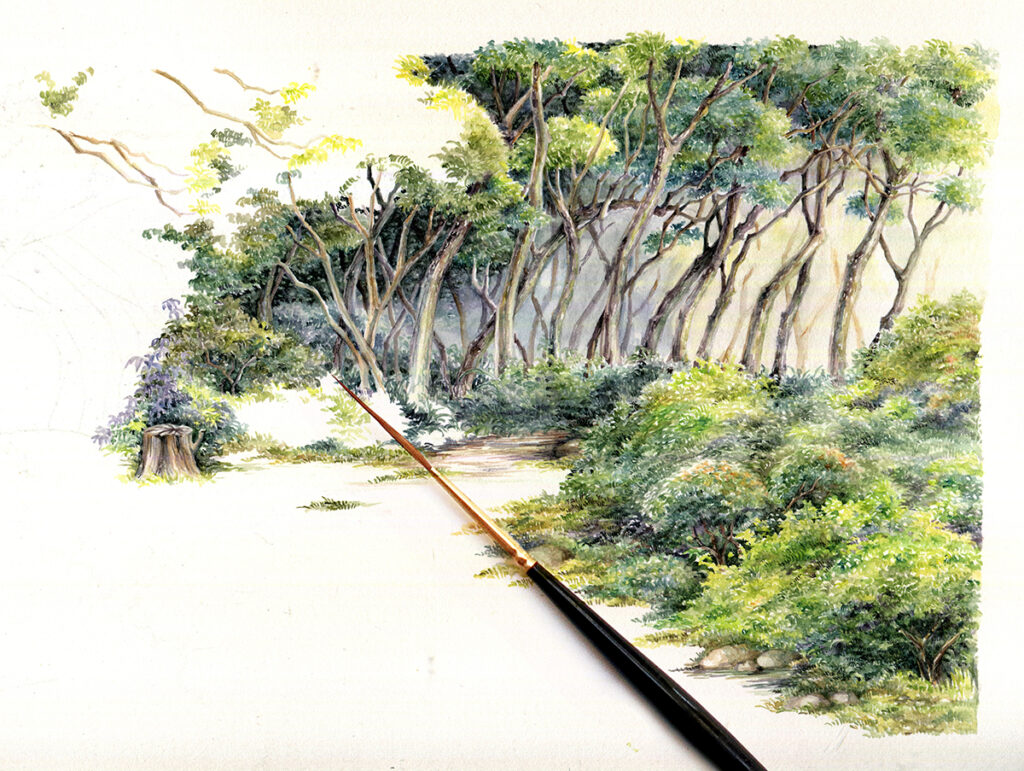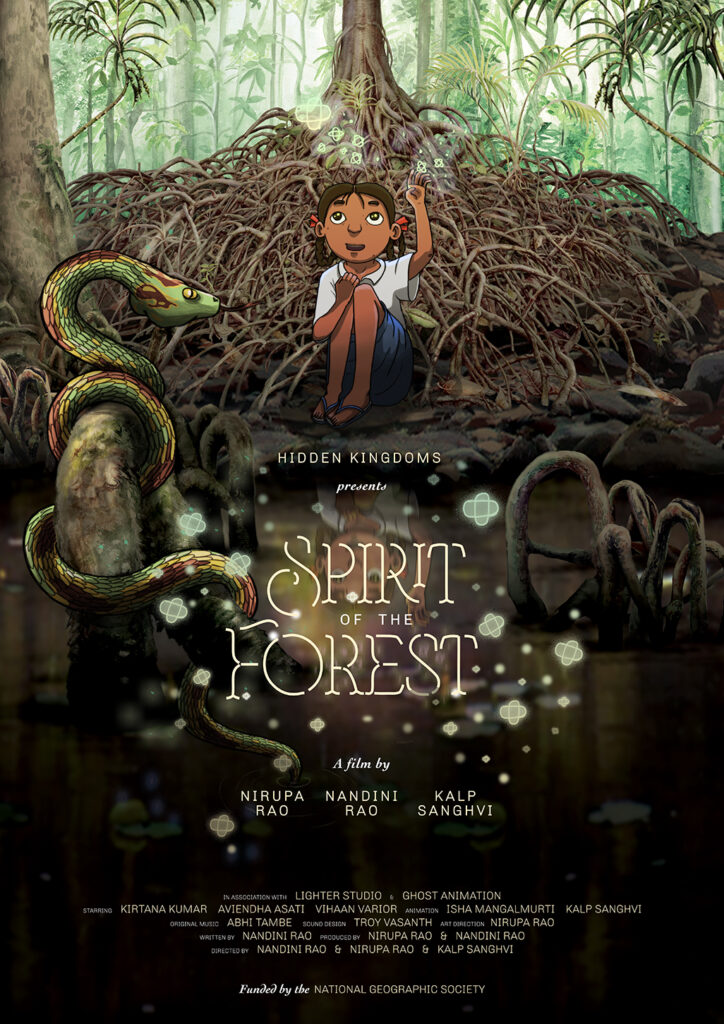
Kolkata based Ghost Animation, which has garnered huge appreciation globally with its climatic dystopia animated film Wade, is coming up with another nature based short film called Spirit of the Forest featuring the hidden gems of the forest. The directorial team consists of Nandini Rao (of Lighter Collective), Nirupa Rao (independent botanical artist) and Kalp Sanghvi (of Ghost Animation).
Nirupa and Nandini are sisters who grew up around the Indian rainforests and come from a botanist family. Being a botanical artist Nirupa was keen to experiment with taking her medium and her landscape to the next level: to bring it alive, or to ‘animate’ it. Her approach was derived from her previous experience of visually documenting rainforest trees for conservation projects in the Western Ghats region of south India. Since these trees are upto 140 ft tall, they are difficult to capture in a camera frame. Furthermore, dense surrounding foliage renders it impossible to distinguish a single species from its environment in a photograph. These things inspired the sisters to come up with this film
Spirit of the Forest tells the story of a little girl from a village in south India who is taking a shortcut through the forest when she stumbles upon a very special place—a ‘sacred grove’. Sacred groves are pockets of the forest largely untouched by human hands thanks to centuries-old indigenous practices of protecting natural habitats.
This particular sacred grove happens to be a wild nutmeg swamp, a freshwater ecosystem uniquely found in this corner of the world. When the girl picks up a nutmeg seed amongst a tangle of aerial roots on the swamp floor, she disturbs the spirit of the forest. What follows is an adventure that illuminates the origins of this ancient swampland: all the way back to the formation of the Indian subcontinent at the breakup of Gondwanaland, through the spiritual practices of her ancestors, and up to the present day.
Commenting on the inspiration behind creating this film, Nirupa told Animation Xpress, “The flora and fauna featured in the film are all accurate to the habitat, and the themes of this ecological fairy tale are derived from contemporary scientific research. We noticed that in most films, plants are used mainly as background scenery. We made Spirit of the Forest to play with the idea of making them central to a storyline.The film aims to weave together all these elements—plants, animals, people, spirituality, culture, art and science—into a beautiful web of life. With the help of an ecologist, we studied which species of trees and shrubs could be found closer or further away from the water according to their level of adaptation to swamp terrain. Species were painted individually, scanned and cut out in photoshop, and then moved around like props within the background ‘set’.”

She further added, “Nandini’s objective while writing the script was to create distinct, relatable characters and weave facts into a journey that audiences could emotionally identify with, while ensuring it was grounded in scientific research and served the project’s educational purpose. Telling the story of the evolution of these ecosystems from Gondwanaland to the present, the film challenges the girl’s presumption that what she was about to take from the grove was ‘just a stupid seed.’ It concludes with a message of hope that what she will carry forward instead is the legacy of her forefathers into the future.”
The film is written by Nandhini Rao whereas the storyboard, animatic and character design is done by Kalp Sanghvi and Isha Mangalmurti worked on key animation layouts. The English version of the film stars Kirtana Kumar, Aviendha Asati and Vihaan Varior. The Kannada version is voiced by Lekha Naidu, Saakshi Gururaj and Poshith R. The animation is perfectly aided by the sound design by Troy Vasanth and original music by Abhi Tambe.
Talking about the association with Ghost Animation, Nirupa shared, “After Nandini and I started working on the idea, we approached Ghost Animation because they have worked on wildlife/ecological themes in the past, and are great with animating animals. The film is heavily character-driven and features a huge range of flora and fauna. To compliment the hand-painted intricate and life-like backgrounds, we chose to go with traditional 2D animation. Using softwares such as TVpaint, Photoshop and Krita helped immensely in maintaining an organic and hand-made style.”
The whole project is funded by the National Geographic Society. Nirupa received a National Geographic Young Explorer Grant in 2016 to make an illustrated book on plants of the Western Ghats. Sharing about her association with the National Geography Society, she mentioned, “I chose to focus on ‘fantastical’ or unusual plants, like carnivores, parasites, or flowers that stink of rotting flesh. It was during this time that I came across a fascinating landscape called ‘Myristica Swamps’—freshwater swamps only found in south India that are named after species of wild nutmeg (scientific name Myristica) that dominate the habitat. There is a profusion of aerial roots developed to survive water-logged terrain—loops of ‘knee’ roots that pop up above the ground and back down, stilt roots that sprout directly from tree trunks, serpentine roots and more. Visually, this seemed like the perfect setting for an animated film. A lot of these swamps are also preserved by local communities for centuries as sacred groves, using myths that are grounded in ecological values. All these elements combined made for a great story. I received a National Geographic Storytelling Fellowship in 2020 in order to make this film.”
Sharing her experience and challenges while directing and producing this film, Nirupa shared, “I had no experience of directing or producing any film, leave alone animation. Nandini is a screenwriter with a background in theatrical acting and directing, as well as production experience on several short films. While it was certainly a challenge to transfer those skills from live action to animation, Kalp Sanghvi and Isha Mangalmurti from Ghost Animation guided us through the process—from turning the script into an animatic, then a line animation, and finally colouring and compositing.”
She further added, “One of the main differences between live action and animation was the fact that every action, expression and gesture of every character, however big or small, had to be thought up and created from scratch, or the moment would be lacking — in live action, we rely so much on human actors to instinctively fill up those spaces with their inimitable magic! Not only that, we had to create the set from scratch. We drew up maps of the swamp, which balanced ecological concepts with the narrative requirements of the film. I used these maps in determining the composition of my background artwork as well.”
The film will have special screenings at several film festivals such as Drama International Short Film Festival (Greece), Bengaluru International Short Film Festival, Cinema Infantil de Florianopolis (Brazil), Fredrikstad Animation Festival (Norway), All Things Environmental Film Festival (India) and Córdoba International Animation Festival (Argentina). The makers are also planning to screen the film in schools across India and are still formulating the rest of their distribution plan.


